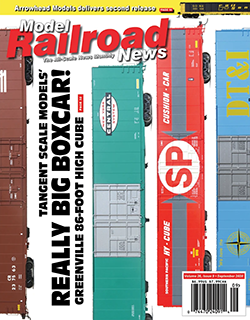 Review by Tony Cook/photos as noted
Review by Tony Cook/photos as noted
Tangent Scale Models expands its line of highly detailed HO-scale freight car replicas with a prototype that will certainly be welcomed by many hobbyists: an 86-foot high-cube boxcar. The first release is available with four road names covering several popular modeling eras, with production-phase and road-specific attributes that buyers of Tangent Scale Models have come to expect.
Big Boxcar
As specialized rolling stock developed for North American railroads in the 1950s and on into the 1960s, freight cars began taking on new looks and came in bigger and longer sizes.
Among the most eye-catching introductions in the 1960s was the arrival of an 86-foot excess-height boxcar designed for transporting automobile parts and other cargo.
The initial prototype design appears to come from American Car & Foundry, though this freight car builder stopped there and didn’t mass-produce 86-foot high-cube boxcars. The mostly three-builder field included Greenville, Pullman-Standard, and Thrall.
In general, this big and tall example of a boxcar offered two distinct looks: one version of this car possessed center-located, insulated twin doors on each side (four doors total), while the other version included a double set of these doors on each side of the car for a total of eight doors. As is often the case with many examples of railroad equipment, at a glance many high-cube boxcars may look the same, but differences abound.

ABOVE: Tangent’s model of New York Central 67171.
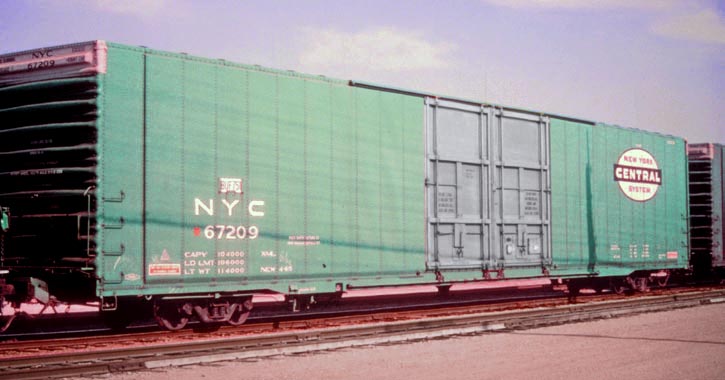
ABOVE: New York Central 67209 comes from a 1965 production group and features an early body style. Across four orders (1964–1966), New York Central amassed a fleet of approximately 350 Greenville-made high cubes. — Author’s collection
One somewhat confusing aspect of these and other excess-height boxcars involves labeling. You’ll find references to these cars as being “Hi-Cube,” “Hy-Cube,” and “High Cube.” Research shows Pullman-Standard used the “Hy-Cube” hyphenated name with a “y,” while the other two labels may not be associated with a specific builder. The two-word “High Cube” seems the common name employed for and by Greenville’s production. As such, this review and the “From the Archive” section later in this edition of Model Railroad News will keep things simple and stick with the two-word label.
Greenville’s High Cube
Greenville was among the companies to build high-cube boxcars and it first entered this segment of rolling stock in 1964, as these cars were being introduced. The builder would continue to produce these giant boxcars into the late 1970s, after competitors had stopped making this type of car. There’s an excellent two-part reference presented in Mainline Modeler’s January and February 2004 editions. Noted freight car authority James Kinkaid provides prototype information for Greenville’s 86-foot high-cube boxcars with numerous pictures, rosters, and a drawing of the four-door example (you’ll find Mr. Kinkaid’s scale drawing reproduced in this edition of MRN). The information states Greenville was the largest producer of 86-foot high-cube boxcars with the majority of its output being the four-door variety.
In his research, Kinkaid divides Greenville’s production into three phases or types. For its new HO-scale replica, Tangent Scale Models went into more detail and divided production further into more than seven types. The seven body styles in Tangent’s tooling collection will provide the company with the ability to reproduce prototypes built between 1964 and 1977.
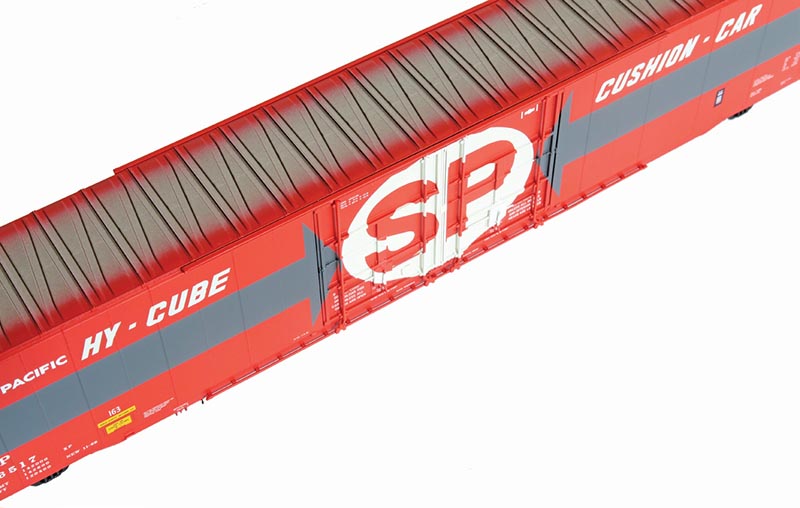
From any angle, this Southern Pacific paint scheme is easily the most eye-catching of all liveries worn by these giant high-cube boxcars. Tangent Scale Models reproduces the red paint overspray landing on the metal roof of this car. This view shows off the separate details surrounding the highly detailed plug doors on this replica. As part of the production process, select components for freight cars are sourced from various companies. Standard Railway Equipment provided corrugated ends and its Stanray roof for use on many high cubes.

Focusing on the four-door prototype, and using Mr. Kinkaid’s sorting of Greenville production into three types, here is a brief rundown of the differences in these cars. Greenville’s Type I car can be spotted by wide vertical indentation on the ends of the car sides, where rows of grab irons appear. These cars are just old enough that select early production offerings featured high-mounted brakes, rooftop running boards, and grab irons running all the way to the roof on select ends of the car. These early production examples lack jacking pad indentations along the sill. Greenville’s Type II high-cube boxcar featured a more narrow recessed or indented section on the ends of the car sides. On these cars, the recessed panel is not much wider than the width of the grab irons in this location. This style high cube includes two jacking pad notches along the sill.
Spotting Greenville’s later era or Type III production sees a return to the wider recessed area for the grab irons along the ends of the car side, with overlapping panels between that area and the doors in the center of the car. This style car also includes two jacking pad notches on its sill.
As noted, at a glance many high-cube boxcars present a very similar appearance. I find examining the sill area along the lower car sides is a quick and easy way to determine who built a car. Greenville’s sill presents a slight fishbelly contour, while competitor Thrall runs a basically straight still from the inside of the stirrup steps across the length of the body. Pullman-Standard’s cars feature a straight sill similar to Thrall’s work, but are easily differientiated by the visible vertical posts present along the sill. As with so many railroad spotting clues, there are always exceptions to the rule. Railroad rebuilds from Norfolk Southern in the 1980s and 1990s present some odd variety that can be a challenge to identify. Santa Fe and Southern Pacific rostered exterior-post examples built by Pacific Car & Foundry that fall outside the norm for spotting features on this series of cars.
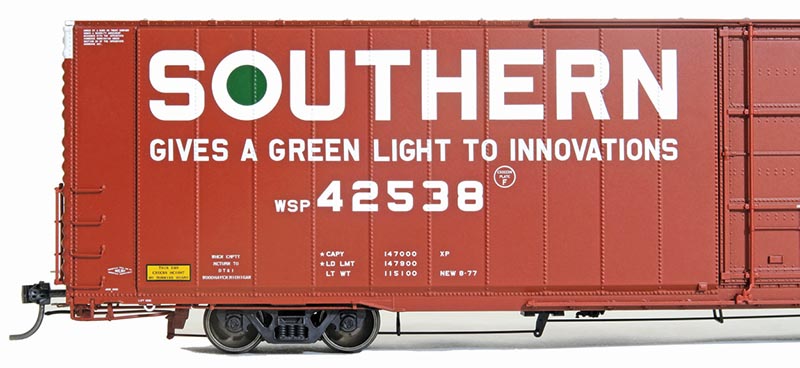
ABOVE: Southern 42538 came with the road’s final delivery of Greenville 86-foot high cubes (42510–42604). Greenville remained a producer of these giant boxcars longer than its competitors and 1977 (when this batch of Southern examples saw production) was near the end of the line for this freight car’s production cycle.
That’s a Big Car!
Tangent Scale Models presents what is easily the most impressive and best example of an 86-foot high-cube boxcar for HO scale ever produced with its new Greenville four-door replica.
Among the highlights, Tangent Scale Models offers all-new tooled accurate rolling bearing truck sideframe with rotating bearing caps. The prototypes came in 70- and 100-ton options and Tangent provides both 33-inch (70-ton) and 36-inch (100-ton) wheels for these new sideframes featuring Barber’s “low boy” prototype.
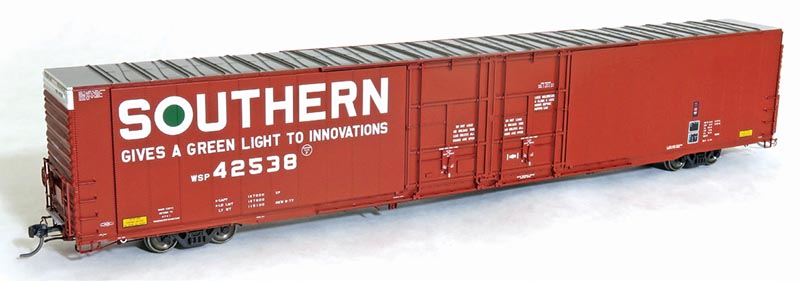
ABOVE: Southern’s slogan “Gives a Green Light to Innovations” and the large road name with clear board indicator inside the “O” helps this otherwise simple livery look impressive. Southern’s Greenville high cubes were all 1970s era construction and like other rosters consisted of mostly four-door exam-ples, as Tangent reproduces. The road did own at least seven Greenville high cubes with eight-door setup, though the other nearly 250 roster members were four-door high cubes.
As was the case for Tangent Scale Models’ 40-foot high-cube boxcar, the end detail on this 86-footer is really well done. The separate wire railings, brake wheel, see-through crossover platform, accurate cushion coupler pocket designs, and coupler cut levers present an incredible realistic appearance for this car.
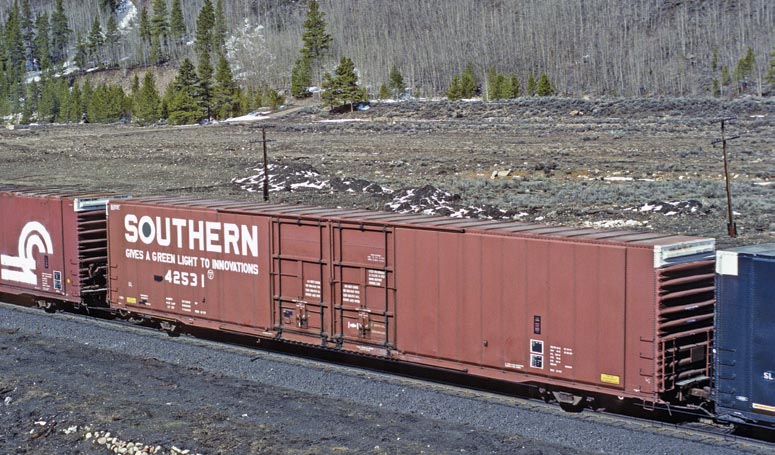
ABOVE: Southern 42531 shows the prototype for Tangent’s HO replica in May 1982, in the consist of a Rio Grande train tackling Tennessee Pass. — David Lehlbach collection
The doors are equally eye-catching with separate vertical runner posts, excellent dimensional appearance to the surface of the doors, and separately applied handles and other fine details.
The model weighs in at 8 ounces and was tested on my loop of 24-inch radius Kato Unitrack. The coupler height checked out perfect on all samples and they performed great. As any seasoned operator can tell you, long cars such as this can present some challenges. I was very pleased with this replica’s ability to smoothly roll around the curves and navigate through turnouts without issue..
HO-scale
Greenville 86-foot four-door high-cube boxcar
MSRP: $52.95
Tangent Scale Models
P.O. Box 6514
Asheville, NC 28816
828-279-6106



